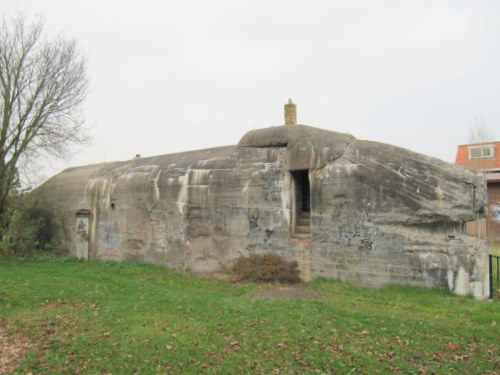Stützpunkt Krimhild Landfront Vlissingen New Abeele bunker type 621
Bunker of the type 621.
Since 2014 there has been an information board at the bunker with the text:
Landfront Vlissingen [/ b]
Vlissingen was an important position during the Second World War. The Germans powerfully fortified the city as part of the "Atlantic Wall" line of defense. To defend the fortress against attacks from the rear, a defense line was constructed on the landward side of the city. This so-called Landfront consisted of a kilometer-long anti-tank ditch with casemates for machine gun or anti-tank gun behind it. The line started in the west of the dunes at Valkenisse and ran across Koudekerke to the Kanaal through Walcheren. On the east side of Walcheren, the Landfront continued in the direction of Ritthem where it ended in the Schorerpolder at Fort Rammekens. Most of the Landfront has been preserved and has been protected as a national monument since 2013.
New-Abeele [/ b]
Nieuwe-Abeele formed the link between the western part of the Landfront and the Canal through Walcheren. Due to the proximity of the canal, it was not possible to build an anti-tank ditch and a dragon's teeth barrier was chosen over the last 150 meters at the Nieuwe Vlissingseweg. Directly behind the dragon's teeth barrier, a garage bunker was built for an anti-tank gun.
A post-war farm, named "Pyramidehoeve" refers to this. A command bunker was built a hundred meters behind the line. This was a type 621 bunker, Gruppenstand. The bunker was equipped with a telephone exchange that allowed contact with the various combat bunkers on the anti-tank ditch. There was also a radio installation so that other command posts could be reached over a great distance. To allow the bunker to blend into the buildings, it was camouflaged as a residential house, complete with painted windows, brick motif and a fake roof.
The original camouflage of the bunker was brought back in 2014.
Photo 1: The front of the bunker.
Photo 2: Inside of Tobruk.
Photo 3: Side of the bunker with the shell well (camouflage well) and two concrete tetrahedra
Photo 4: Back of the bunker.
Photo 5: After the war years, the bunker has stood there for years.
Do you have more information about this location? Inform us!
Source
- Text: Mia van den Berg / Stichting Bunkerbehoud
- Photos: Mia van den Berg
Nearby
Museum
- Stützpunkt Leuchtenburg - Artillery observation bunker Type 143 Flushing - Vlissingen
- Keizersbolwerk Vlissingen - Vlissingen
- Fortress Rammekens - Ritthem
Point of interest
- Fire apparatus 'The Magirus' - Middelburg
- NSVO District Office Zeeland - West-Souburg
- Toorenvliedt Estate - Middelburg
Monument
- War Memorial Oost- en West Souburg - West Souburg
- Monument Buffalo amphibious vehicle - Middelburg
- Memorial Deported Jews of Zeeland - Middelburg
Cemetery
- Dutch War Grave Oost-Souburg - Oost-Souburg
- Commonwealth War Graves Flushing (Vlissingen) - Vlissingen
- Dutch War Graves (Noorderbegraafplaats) - Vlissingen
Remembrance Stone
- Stumbling Stone Langevielesingel 66 - Middelburg
- Stumbling Stones Lange Geere 30 - Middelburg
- Stumbling Stone Gortstraat 28 - Middelburg
Fortification
- Stützpunkt Krimhild Landfront Vlissingen New Abeele Bunker type 629 - Middelburg
- Tank Barrier Middelburg - Middelburg
- Bunker Type 631 Groot Abeele - Groot Abeele





